|
|
|
Sort Order |
|
|
|
Items / Page
|
|
|
|
|
|
|
| Srl | Item |
| 1 |
ID:
140958
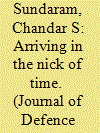

|
|
|
|
|
| Summary/Abstract |
Today, military historians as well as those dealing with colonial South Asian history tend to overlook the fact that during the First World War, the Indian Army was Britain’s strategic reserve. It vitally despatched over 150,000 troops to the Western Front to shore-up the British sector in the critical period of 1914-1915. To the Indian sepoys who crossed the kala pani to fight, die or be wounded in the trenches there, it was a jarring initiation into modern industrialised warfare. This article examines that episode and advances two arguments: first, that, contrary to accounts written as recently as the 1980s, Indian sepoys performed quite well in the trenches; second, that racial concerns and the advent of the Kitchener armies, rather than a poor combat record, led to their transfer from the Western Front at the end of 1915.
|
|
|
|
|
|
|
|
|
|
|
|
|
|
|
|
| 2 |
ID:
133802
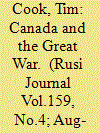

|
|
|
|
|
| Publication |
2014.
|
| Summary/Abstract |
Britain's war effort was crucially aided by its Dominions, with Canada's experience of the First World War a prime example of this fundamental military contribution
Canada's contribution to the war effort on the Western Front was of fundamental importance throughout the Great War. Tim Cook traces how, over four years, what started as a little-organised contingent of 31,000 troops of mostly citizen-soldiers grew into an effective fighting force that made significant contributions to the final victory over the Central Powers.
|
|
|
|
|
|
|
|
|
|
|
|
|
|
|
|
| 3 |
ID:
061646
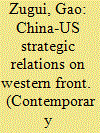

|
|
|
| 4 |
ID:
177948
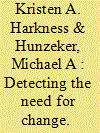

|
|
|
|
|
| Summary/Abstract |
This article addresses a gap in the literature on military adaptation by focusing on the first step in the adaptive process: detecting failure. We argue that institutionalised feedback loops are a critical mechanism for facilitating detection. Feedback loops are most effective when they filter information and distribute lessons learned to senior tactical commanders. In turn, effective filtration depends on incorporating frontline soldiers and specialists into intelligence cells while creating a protected space for dissent. We evaluate our theory against both irregular and conventional wars fought by the British Army: the counterinsurgency campaign in the Southern Cameroons (1960–1) as well as the evolution of British assault tactics on the Western Front of the First World War (1914–18).
|
|
|
|
|
|
|
|
|
|
|
|
|
|
|
|
| 5 |
ID:
142194


|
|
|
|
|
| Publication |
New Delhi, Bloomsbury Publishing India, 2015.
|
| Description |
xxvii, 224p.: maphbk
|
| Standard Number |
9789384052911
|
|
|
|
|
|
|
|
|
|
|
|
Copies: C:1/I:0,R:0,Q:0
Circulation
| Accession# | Call# | Current Location | Status | Policy | Location |
| 058394 | 940.40954/BAS 058394 | Main | On Shelf | General | |
|
|
|
|
| 6 |
ID:
121532
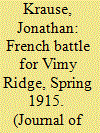

|
|
|
|
|
| Publication |
2013.
|
| Summary/Abstract |
The unprecedented scale of trench warfare in the First World War posed a series of challenges to attacking forces. This article tracks the early French steps to develop a coherent doctrine for launching offensives against established trench systems, focusing on a specific battle in May-June 1915: Second Artois. This battle would be the first based on lessons learned and digested by the French army after its initial tentative efforts at trench warfare from December 1914 to March 1915. As such it provides an interesting starting point for an analysis of the French army's development of trench tactics in the First World War and of the part this played in the general effort made by the two sides to find ways to break the post-1914 stalemate on the Western Front.
|
|
|
|
|
|
|
|
|
|
|
|
|
|
|
|
| 7 |
ID:
151467
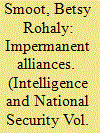

|
|
|
|
|
| Summary/Abstract |
The extent of practical cooperation in the business of communications intelligence and communications security between the United States, France, and the United Kingdom on the Western Front has not been documented in depth. This paper will examine cryptologic cooperation between the three allies during the First World War, discuss why the relationships ended after that war, and argue that these impermanent alliances did not shape the cryptologic relationship between the U.S. and the UK that formed during the Second World War.
|
|
|
|
|
|
|
|
|
|
|
|
|
|
|
|
| 8 |
ID:
132130
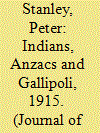

|
|
|
|
|
| Publication |
2014.
|
| Summary/Abstract |
As one of the world's most populous nations, India today has one of its largest armies, which stands ready to defend the nation. A century ago, India's army was similarly large but was used to defend the British empire as well as Britain's Indian possessions. In 1914, the Indian Army (a force of about 200,000 men) provided a vast reservoir of trained military manpower, one immediately used by Britain as it entered the Great War. In the war's earliest weeks, from August 1914, the Indian Army was mobilised for service, and within months the first Indian troops saw service against imperial Germany, in East Africa, but also on the Western Front in France and Belgium.
|
|
|
|
|
|
|
|
|
|
|
|
|
|
|
|
| 9 |
ID:
123604
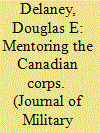

|
|
|
|
|
| Publication |
2013.
|
| Summary/Abstract |
The Canadian Corps of 1918 was not an entirely self-made machine. It needed outside help to develop into the highly effective fighting formation that it became by war's end. Between 1914 and 1918, the British Army sent scores of officers to Canadian formations, to make up key command and staff deficiencies in the Canadian Expeditionary Force and to train selected officers to take their places. Canadian political pressure ensured that these replacements were Canadian. The product of this somewhat ad hoc mentoring process was a Canadian Corps, commanded and staffed almost entirely by Canadian officers, that could keep pace with any British Expeditionary Force formation on the Western Front.
|
|
|
|
|
|
|
|
|
|
|
|
|
|
|
|
| 10 |
ID:
128850
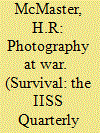

|
|
|
|
|
| Publication |
2014.
|
| Summary/Abstract |
A thematic selection and analysis of war photography across 165 years has tremendous explanatory power about the nature of modern war and the human experience in war and its aftermath. The year 2014 brings centennial commemorations of events that helped make the twentieth century the bloodiest in human history. Among these are the assassination of Archduke Franz Ferdinand on 28 June, Germany's invasion of Belgium and France on 4 August, and the First Battle of the Marne in early September - the battle that halted the German offensive and ushered in an unprecedented period of stalemated, destructive warfare on the Western Front. As historian Margaret MacMillan has observed, the First World War still haunts us not only because of the scale of the carnage and suffering, but because so many believed that the early-1900s version of globalisation and interdependence had rendered war futile. The comparisons to today seem obvious, as the United States and European nations cut military budgets based, in part, on the belief that large-scale armed conflicts are relics from a barbarous past. If, however, peace remains as the Ancient Greek historian Thucydides described it over 2,500 years ago - 'an armistice in a war that is continuously going on' - understanding war and warfare will remain important for preventing conflict, as well as for its effective conduct. Understanding war's human, psychological and social dimensions requires an interdisciplinary approach and study across multiple genres including literature, art, film and photography.
|
|
|
|
|
|
|
|
|
|
|
|
|
|
|
|
| 11 |
ID:
128540
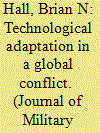

|
|
|
|
|
| Publication |
2014.
|
| Summary/Abstract |
This article seeks to contribute to recent scholarly analysis of the British Army's military performance and its leadership's willingness and ability to adapt during the First World War (1914-1918) by examining a maligned, though vital, aspect of its command and control system, communications. It offers a comparative assessment of the development and contribution of communications to British operations beyond the Western Front and concludes that the army was, on the whole, remarkably successful at adapting its communications system to suit the demands of fighting a modern, global conflict.
|
|
|
|
|
|
|
|
|
|
|
|
|
|
|
|
| 12 |
ID:
132966
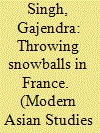

|
|
|
|
|
| Publication |
2014.
|
| Summary/Abstract |
The arrival of Indian sipahis (or 'sepoys') to fight alongside soldiers of the British Expeditionary Force in France in October 1914 was both a victory and a source of concern for the British Raj. It proved to be the zenith of martial race fantasies that had been carefully codified from the 1890s, and birthed fears about the effects that Europe and the rapidly intensifying conflict on the Western Front would have upon the 'best black troops in the world'. The situation resulted in the appointment of a special military censor to examine the letters sent to and from Indian sipahis and compile a fortnightly summary of Indian letters from France for the duration of the First World War. This paper investigates a portion of the letters contained in these reports. More particularly, it investigates the life of a single chain letter and the effect its chiliastic message had upon Muslim troops of the Indian Army during the First World War. As the letter was read, rewritten, and passed on, it served as a rejoinder to missionary efforts by the Ahmadiyya Movement, reinterpreted as a call for soldiers to purify their own bodies and oppose interracial sexual relationships, before, finally, being used as a critique of the British war effort against the Ottoman empire.
|
|
|
|
|
|
|
|
|
|
|
|
|
|
|
|
| 13 |
ID:
114430
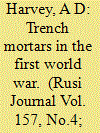

|
|
|
|
|
| Publication |
2012.
|
| Summary/Abstract |
The emergence of trench warfare on the Western Front proved to be fertile ground for the development of the mortar. Yet for all their worth, trench mortars struggled to compete with more traditional forms of artillery in the British Army, their crews often working other duties, and full integration with infantry units was lacking even as late as 1918.
|
|
|
|
|
|
|
|
|
|
|
|
|
|
|
|
| 14 |
ID:
133806
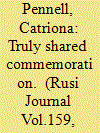

|
|
|
|
|
| Publication |
2014.
|
| Summary/Abstract |
The memory of the war in the British Isles - and Ireland in particular - has been inevitably coloured by political agendas, and the Irish contribution has largely been forgotten. During the First World War, around 35,000 Irishmen - hailing from both the north and south of the island - gave their lives fighting for the British Empire, of which Ireland was then a part. Many tens of thousands more served in Britain's armed forces in theatres around the globe, and especially on the Western Front. Yet this contribution has only recently been recognised by the general pubilc in Ireland; and is largely overlooked by those in Britain. Catriona Pennell explores how tempestuous relationships and political division throughout the twentieth century have coloured the memory of the war within the British Isles.
|
|
|
|
|
|
|
|
|
|
|
|
|
|
|
|
| 15 |
ID:
133494
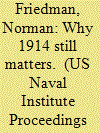

|
|
|
|
|
| Publication |
2014.
|
| Summary/Abstract |
Imagine that your closest trading partner is also your most threatening potential enemy. Imagine, too, that this partner is building a large navy specifically targeted at yours, hence at the overseas trade vital to you. Does that sound like the current U.S. situation with respect to China? It was certainly the British situation relative to Germany a century ago, on the eve of World War I. History never repeats, but it is often instructive to look at the mistakes of the past. The worse the mistakes, the more instructive. No one looking at the outbreak and then the course of World War I can see it as anything but a huge mistake. Hopefully we can do better.
|
|
|
|
|
|
|
|
|
|
|
|
|
|
|
|
|
|
|
|
|